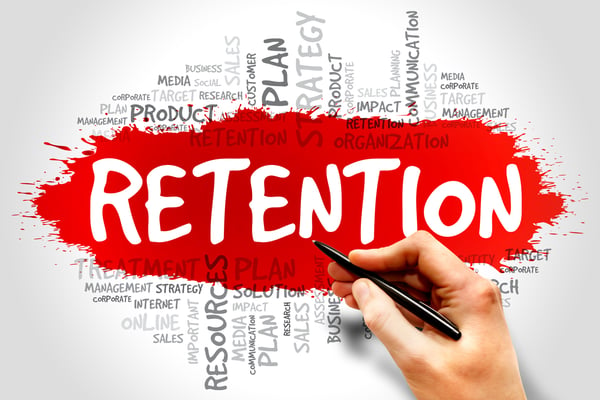How to Retain Customers and Develop Brand Advocates - Part 3

Part 3 of 3: Winning Retention Marketing Strategies
Retention marketing isn’t meant to replace acquisition marketing, but to work alongside it as part of your growth strategy. The activities associated with retaining customers and/or increasing customer value through re-purchasing or up-selling products and services, is less expensive than acquisition marketing.
While you need both acquisition and retention marketing, you will get a better return from your investment in retention marketing and create customers for life.
In the previous blog post, we discussed how to develop a retention marketing program that specifically addresses the needs of your business. But are there proven retention marketing strategies or tactics that should be considered regardless?
While not all the strategies below are applicable to every business, they are proven strategies used by the world’s best brands. Together they will provide a good starting point for consideration as you develop your long-term retention marketing plan.
1. Act on Customer Feedback
This is the most valuable—and often forgotten—tool at your disposal in retention marketing. You can ask your customers for feedback on just about anything from the product to the sales process to your ongoing communications with them. Develop a process for asking customers regularly for feedback and for reporting this information throughout your organization.
Demonstrate to your customers that you’re listening by responding to their feedback and implementing their best suggestions into your business practices.
Especially in B2B environments, you may consider a customer advisory panel as one of your feedback strategies. These well-chosen customers would be the ones to help you refine your product or service offering and even alert you to potential problems before they start brewing.
This is also a great strategy if a big portion of your business comes from a few key players. Involving those key players in your business can develop loyal brand advocates for you. The key is your ability to act on their input—something to consider carefully before implementing this type of strategy.
2. Start Retaining with Good Onboarding
The process of helping your customers install or implement your product and optimize all its features will set the stage for your long-term relationship. The more complex the product, the more important this is.
Rather than leaving your customers to their own devices, teach them all there is to know about using your product to meet their goals. This involves an in-depth understanding of the process your customers go through to implement your product in their business. Also, customize training and communications materials to meet their needs during the onboarding experience.
3. Understand your Customer Lifecycle
While the early stages of the customer lifecycle deal with awareness, preference and purchase, retention marketing addresses the product and customer experience that can lead to advocacy. After successfully purchasing and implementing your product, what are the issues they will need or want to address next?
Putting yourself in their shoes, understanding their business, and developing tools and communications to help address their issues will create loyal customers for life.
A retention marketing plan addresses key triggers and needs along the customer’s lifecycle—whether it’s a product or service. It delivers customer communications that address needs along the way, always in the way that’s most relevant for the customer.
A newsletter or blog are great communications tactics for delivering relevant and timely messages. Both can be automated easily, making them a particularly cost-effective way of reaching customers on a regular basis. Many companies today also use short-segment video to provide customer education.
You can measure the effectiveness of these types of communications by including response opportunities, whether these are purchase opportunities or requests for more information. In your ongoing evaluations to hone your communications plan, be sure to monitor for satisfaction with relevance, quality, timeliness and frequency.
4. Reactivation
If you have customers that are no longer using or engaged with your product, consider a reactivation campaign. This is particularly effective with digital products and industries as it is relatively easy to create a series of communications via email, social or targeted display that invite your customers to re-engage with your product.
Retailers and even nonprofit organizations use reactivation campaigns all the time: “We haven’t seen you in a while and we miss you.” Similar tactics also can be implemented in other industries, and in B2B as well as B2C environments. As with other tactics, it’s important to track results to continuously improve your success.
5. Reward Customer Loyalty
Developing methods to reward long-term or frequent customers may be appropriate for some businesses, if it can be done by leveraging volume or consistency without jeopardizing profitability. Sometimes referred to as loyalty programs, these incentives should be considered carefully before offered.
There are many big-name examples of loyalty programs gone bad, those that negatively affected profitability as well as customer loyalty. And there are so many consumer loyalty programs today—most of which were originally launched with loyalty cards—that the cards themselves became a fodder for late night comedians.
However, if you’re one of those businesses where 10% of your customers generate the majority of your revenue, you may want to develop a program that ensures that they are happy, loyal customers.
6. Competitive Strategies
In both B2B and B2C, it helps to monitor your competition and adjust your retention plans as necessary. You never know when a new competitor will pop up or change tactics that may put one or more of your customer segments at risk.
With a fitness industry client, we recently identified a new competitor within the three-mile sweet spot of customers. Industry intelligence alerted us to the trend for that competitor to offer deep discounts for membership as part of their grand opening activities.
Knowing that they would be targeting some of our customers, we identified those customers for which the new competitive facility would be closer than ours. Then we developed specialized communications to those members for the six months prior to the grand opening to facilitate greater engagement and satisfaction—and most importantly, to highlight the value and key differentiators we provided.
The same type of activity can occur in B2B environments when a new competitor enters the market or, in the case of a software client, a regional competitor became more aggressive with pricing within their territory. Working closely with sales teams to monitor competitive developments—and then developing plans to address them—can pay nice benefits in retention.
7. Customer Experience is King
Sometimes there’s nothing more effective in customer retention than good ongoing customer management practices. It would be remiss to not call this out, since no retention marketing program could possibly overcome poor customer experiences. Customer retention programs ideally will complement positive customer experiences and help create new ones.
Today, the range of possibilities to evaluate and create costumer experiences is quite broad, from good old-fashioned principles like being nice and managing expectations to sophisticated customer experience mapping. All are worthwhile to ensure that you keep the customers you worked so hard to acquire.
In three posts, we’ve shared the rationale for making retention marketing part of your growth strategy, how to develop a retention marketing plan and some winning retention strategies. Are you ready to get started? Please share your comments below or contact Paige Chadwick at PChadwick@chiefoutsiders.com.
Topics: CEO Marketing Strategy, Marketing Strategy, Customer Satisfaction
Thu, Oct 10, 2019.png?width=1500&height=398&name=CO_Corporate%20Logo%202021_4C_HOR_FNL-1%20(1).png)


